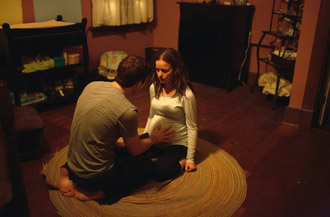|
|
Movie Review: Devil's DueBy Matthew HuntleyJanuary 21, 2014
From here on out, strange and creepy things start to happen. Based on the genre, and because we’re smart enough to know way in advance where the plot is going, we can pretty much check these occurrences off one by one: Sam develops bruises on her body but is unable to explain where they came from; an ultrasound of the baby causes technical glitches on the monitor; Sam, who’s a vegetarian, impulsively tears open a package of ground beef at the grocery store and begins to eat it like a rabid animal; and she experiences sudden nosebleeds and spikes in strength that give her the power to break windows and throw people across the room. There’s also the issue of the creepy guys who watch her from across the street. Given the movie’s title, not to mention the Bible verse that opens the film - “Children, it is the last hour, and as you have heard that antichrist is coming, so now many antichrists have come…” 1 John: 2:18 - it’s pretty obvious what, or who, is gestating inside of Sam. But does the movie put any kind of original twist on this premise or offer any new insight into the underlying idea? Not really. It’s all standard horror fodder and the movie dishes out all the usual conventions, such as the family dog suspecting something is awry (somehow dogs are always the first to know); or a priest (Sam Anderson) sensing an evil presence and bleeding out uncontrollably. You get the idea. If you’ve seen any demonic possession movie before, Devil’s Due will not seem like anything new. But unlike some of its brethren, it’s not particularly scary, thrilling or really all that interesting. For its mere 89 minute runtime, we patiently wait for something gripping or frightening to happen, but because every scene feels like a retread, it never does. The plot rolls out exactly as we expect it to, which makes it something we have to bear instead of enjoy. I mentioned the movie isn’t badly made, and it isn’t. On a technical level, it’s competently shot and put together, even though we question the narrative purpose behind the found footage approach. Aesthetically, I know what the filmmakers wanted to accomplish, but how did they want us to interpret it from the world of the movie? Did they want us to think someone took all the footage from the various cameras that recorded the events and spliced it together?
|

|
|
|

|
Thursday, October 31, 2024
© 2024 Box Office Prophets, a division of One Of Us, Inc.


